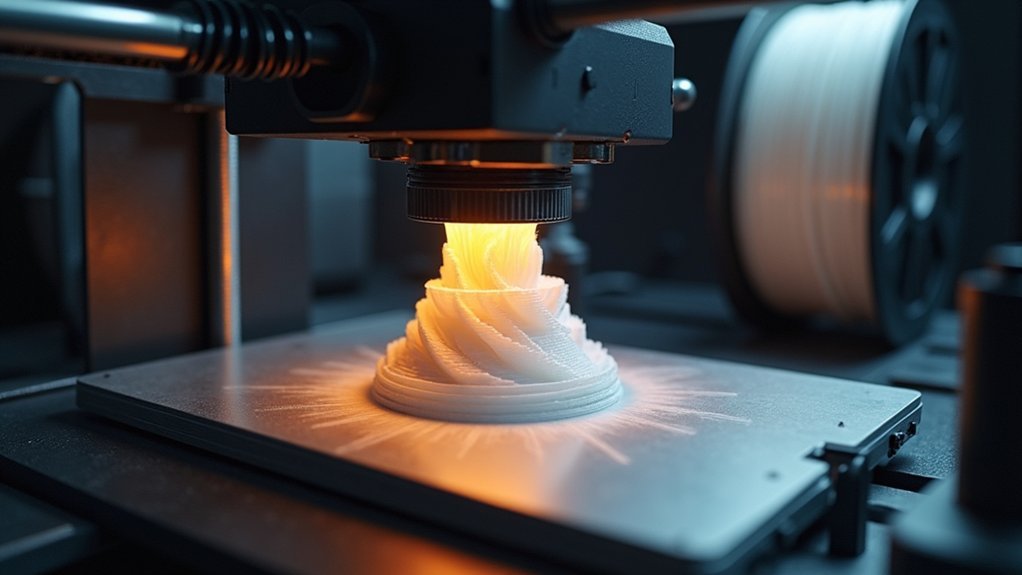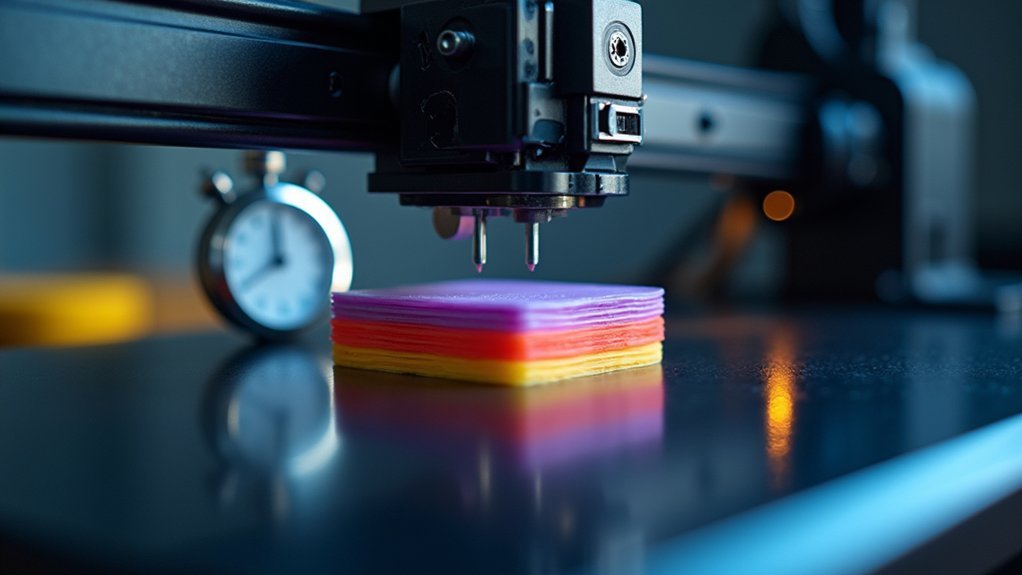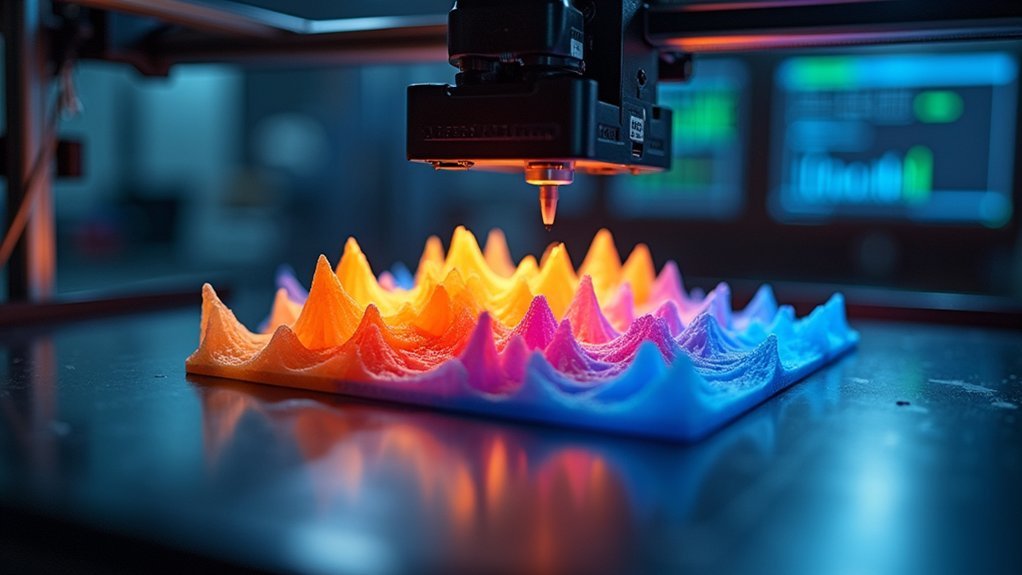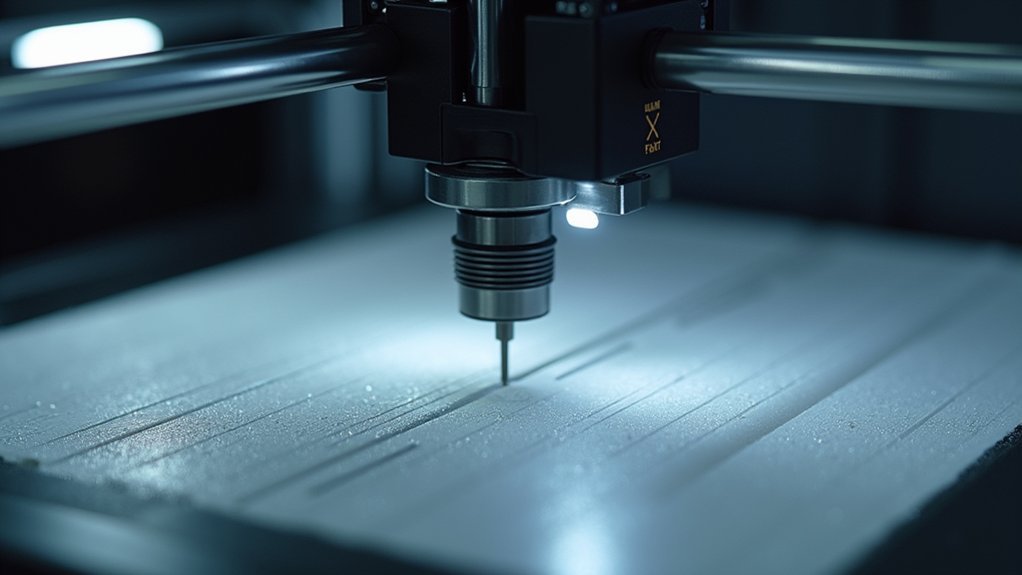Adaptive layer heights boost your 3D printing speed by intelligently varying thickness based on your object’s geometry. You’ll use thicker layers (0.3-0.4mm) for simple, stable areas and thinner layers (0.1-0.15mm) only where intricate details require precision. This dramatically reduces your total layer count—sometimes from 355 to just 201 layers—cutting print time by up to 30%. The technology automatically analyzes surface angles and complexity, optimizing material flow while maintaining quality where it matters most for enhanced efficiency.
Understanding How Adaptive Layer Heights Work

When you’re 3D printing complex models, adaptive layer heights automatically adjust the thickness of each layer based on your object’s geometry. Instead of using one uniform layer thickness throughout your entire print, this technology analyzes each section and applies thicker layers to stable, less detailed areas while using thinner layers for intricate features requiring precision.
This smart approach dramatically impacts your print speed by reducing the total number of layers needed. For instance, you might print a model with only 201 adaptive layers compared to 355 uniform layers.
You’ll spend less time printing simple geometries while maintaining quality where detail matters most. The system optimizes layer thickness strategically, delivering faster completion times without sacrificing the fidelity of complex designs.
The Science Behind Variable Layer Thickness
As your 3D printer analyzes each layer’s geometry, it calculates the ideal thickness by evaluating surface angles and detail complexity. The algorithm examines upcoming layers to determine where thin sections preserve intricate features and where thick sections can accelerate printing without sacrificing quality.
Adaptive layer heights work by concentrating precision where you need it most – vertical details and sharp shifts – while using thicker layers on gradual slopes and stable areas.
Smart layer thickness allocation puts detail precision exactly where complex geometry demands it while accelerating print speeds through simpler sections.
This intelligent distribution minimizes the stairstep effect on complex surfaces while dramatically reducing total layer count. Your printer fundamentally creates a custom thickness map, balancing speed against detail requirements.
The result delivers faster production times through fewer overall layers while maintaining fidelity in critical areas, optimizing both material usage and surface finish quality.
Time Savings Through Optimized Layer Distribution

You’ll achieve substantial time savings by leveraging thick layers in geometrically stable areas while concentrating detail-focused thin layers only where they’re essential.
This optimized distribution lets you print faster overall since you’re not wasting time applying unnecessary detail to simple surfaces.
The result is a strategic approach that maintains quality where it matters while dramatically cutting print duration through intelligent layer allocation.
Thick Layers Speed
One significant advantage of adaptive layer heights lies in their ability to dramatically reduce print times through strategic layer distribution.
When you use thicker layers in stable geometry regions, you’re fundamentally cutting down on the total number of layers needed for your print. Instead of working with 355 layers using standard heights, you’ll only need around 201 layers with adaptive settings.
This reduction translates directly into decreased printing time since your printer spends less time moving between layers. You’ll maximize efficiency by applying thicker layers where intricate details aren’t necessary, while reserving thinner layers for complex areas.
This strategic approach can save you up to 30% in printing time compared to traditional fixed layer methods.
Detail Area Focus
Two critical zones emerge when you implement adaptive layer heights: areas requiring fine detail and regions where speed takes priority.
You’ll allocate thinner layers precisely where intricate geometry demands higher resolution, while maximizing thickness in stable sections. This targeted approach transforms your printing strategy from uniform layer distribution to intelligent resource allocation.
Your adaptive layer height system automatically identifies complex features like overhangs, curves, and fine details, applying appropriate layer thickness accordingly.
Rather than using 0.1mm layers throughout an entire model, you’ll use thin layers only where necessary and thick layers everywhere else. This optimization maintains exceptional print quality in detailed sections while dramatically reducing overall print time.
The result: fewer total layers, faster completion, and superior surface finish where it matters most.
Reducing Total Layer Count for Faster Prints
When you implement adaptive layer heights, you’re fundamentally changing how your printer analyzes and approaches different geometric sections of your model.
Your slicer performs optimized geometry analysis to identify which areas need fine detail and which can handle thicker layers, then applies strategic layer distribution accordingly.
This intelligent approach lets you cut your total layer count dramatically—sometimes reducing 355 layers down to just 201—while maintaining the quality you need in critical areas.
Optimized Geometry Analysis
Although traditional 3D printing relies on uniform layer heights throughout an entire model, adaptive layer height technology analyzes your part’s geometry to strategically assign varying thicknesses that dramatically reduce total layer count.
This intelligent system examines each section of your model, identifying areas where maximum layer thickness won’t compromise quality while detecting regions requiring finer detail resolution.
When you implement adaptive heights, you’ll see dramatic reductions in total layers—from 355 layers down to just 201 in many cases.
The geometry analysis automatically applies thicker layers in uniform, stable regions where structural integrity remains intact.
Meanwhile, complex areas with intricate details receive thinner layers for precision.
This strategic approach eliminates unnecessary layer changes, optimizing your printing workflow while maintaining the quality standards your projects demand.
Strategic Layer Distribution
By strategically distributing layers based on your model’s geometric requirements, you’ll achieve substantial time savings that transform how efficiently your printer operates.
Adaptive layer height technology intelligently assigns thicker layers to stable geometry regions while reserving thinner layers exclusively for intricate details. This smart distribution dramatically reduces your total layer count – users report dropping from 355 layers down to just 201 layers, cutting significant time from each print job.
Your printing process becomes far more efficient as the system automatically optimizes layer thickness according to part complexity.
You’ll maintain exceptional detail quality in critical areas while accelerating through simpler sections. This strategic approach eliminates unnecessary precision where it’s not needed, maximizing speed without sacrificing the fine details that matter most in your finished parts.
Smart Geometry Analysis for Speed Enhancement

Anyone who’s watched a 3D printer work knows the painstaking process of laying down hundreds of identical layers, regardless of whether you’re printing a smooth cylinder or an intricate figurine. Smart geometry analysis changes this by intelligently scanning your model’s complexity before printing begins. The software identifies smooth surfaces where you can use thicker layers and detailed areas requiring precision. This Adaptive Layer approach dramatically cuts print time by reducing total layer count—think 201 layers instead of 355 for the same model.
| Geometry Type | Layer Thickness | Speed Benefit |
|---|---|---|
| Smooth surfaces | Thicker layers | Maximum acceleration |
| Complex details | Thin layers | Quality preservation |
| Transitioning zones | Variable thickness | Balanced optimization |
You’ll see faster production without sacrificing quality in critical areas.
Balancing Detail Preservation With Print Velocity
When you’re printing intricate models, the real challenge lies in determining exactly where to apply thin layers for crisp details versus thick layers for rapid progress.
Adaptive layer technology solves this dilemma by automatically analyzing your geometry and strategically varying layer heights throughout your print.
Balancing speed with high quality becomes achievable through smart thickness distribution:
- Detailed sections receive thinner layers (0.1-0.15mm) to eliminate stairstep effects and preserve intricate features.
- Uniform geometry areas utilize thicker layers (0.3-0.4mm) to accelerate printing velocity considerably.
- Maximum variation parameters let you control how dramatically layer heights change between sections.
- Base layer adjustments help manage the increased layer count (typically jumping from 201 to 355 layers) without excessive time penalties.
This approach delivers exceptional surface finish where it matters most.
Material Flow Optimization in Adaptive Printing
When you implement adaptive layer heights, you’ll need to recalculate flow rates dynamically to match each layer’s thickness and guarantee consistent extrusion.
You must also manage extrusion width carefully as thicker layers require wider beads to maintain proper adhesion and structural integrity.
These adjustments help prevent material degradation that occurs when filament dwells too long in the hotend during changes between different layer heights.
Flow Rate Calculations
As your 3D printer shifts between different layer heights, it must recalculate material flow rates to maintain consistent extrusion throughout the adaptive printing process.
These flow rate calculations guarantee ideal material deposition regardless of whether you’re printing thick uniform sections or detailed areas requiring thinner layers.
Your printer’s adaptive system manages material flow through precise mathematical adjustments:
- Volume compensation – Adjusts extrusion speed based on layer height changes to maintain consistent material volume
- Pressure regulation – Modifies nozzle pressure to prevent over-extrusion in thick layers and under-extrusion in thin ones
- Speed synchronization – Coordinates print head movement with material flow for seamless changes
- Temperature optimization – Adjusts heating parameters to guarantee proper material viscosity across varying flow rates
This mathematical precision eliminates gaps and strengthens layer adhesion throughout your print.
Extrusion Width Management
Building on precise flow rate control, your 3D printer’s extrusion width management takes material optimization one step further by dynamically adjusting how much filament spreads horizontally as it’s deposited.
When you’re printing stable regions with thicker layers, wider extrusion width lets your printer deposit more material rapidly, cutting overall print time considerably. This strategic adjustment works seamlessly with adaptive layer heights to minimize gaps between extrusions, creating denser, stronger prints in complex geometries.
You’ll notice improved layer adhesion as the enhanced bonding between layers maintains part strength while accelerating the printing process.
The dynamic width adjustments facilitate smoother shifts between different layer heights, optimizing print quality and preventing under-extrusion issues that could compromise your final results.
Material Degradation Prevention
Since material degradation from prolonged heat exposure can compromise your print’s structural integrity, adaptive layer heights strategically minimize the time filament spends in the melt zone by varying thickness according to geometric requirements.
You’ll preserve material properties through several key mechanisms:
- Optimized heat exposure – Thicker layers in simple sections reduce overall melting time while maintaining quality.
- Strategic thinning – Thinner layers only appear where detail demands it, preventing unnecessary thermal stress.
- Enhanced density control – Reduced gaps between extrusions improve layer adhesion without excessive melting.
- Ratio compliance – Maintaining proper layer-to-nozzle diameter ratios prevents material degradation and part failure.
This targeted approach guarantees faster printing speeds in uniform areas while protecting material integrity where precision matters most.
Maximizing Thick Layers in Simple Geometry Areas
One of the most significant advantages of adaptive layer heights lies in maximizing layer thickness throughout areas with simple, stable geometry.
You’ll dramatically reduce print time by utilizing thick layers where complexity is minimal, requiring less layers overall to complete your model. For instance, your print might use 201 layers with adaptive heights compared to 355 layers with uniform settings, demonstrating remarkable efficiency gains in simpler sections.
When you implement thicker layers in uniform areas, you’re not only accelerating the printing process but also optimizing material usage.
This approach effectively balances your need for fine detail in complex features while maximizing speed where high resolution isn’t necessary, making your entire printing workflow more efficient.
Strategic Layer Height Selection for Complex Models
When dealing with complex models that feature both intricate details and simple geometric sections, you’ll need to strategically assign layer heights based on each area’s specific requirements.
This adaptive layer height approach transforms your printing experience by optimizing both speed and quality simultaneously.
Here’s how to implement strategic layer selection:
- Concentrate finer details vertically – Position intricate elements in vertical orientations where thinner layers are essential for accuracy.
- Apply thicker layers to flat regions – Use maximum layer heights on uniform surfaces to accelerate printing.
- Reduce total layer count considerably – Transform 355 layers into just 201 layers through smart height assignment.
- Balance speed with resolution – Maintain detail fidelity while achieving substantial time savings across your entire print.
Performance Gains Across Different Printer Types
Different printer technologies demonstrate varying degrees of improvement when implementing adaptive layer heights, with some models achieving more dramatic performance gains than others.
Form 3 and Form 3B printers excel with this technology, strategically optimizing speed for simpler sections while preserving detail where needed. You’ll see substantial efficiency improvements when adaptive heights produce models with 201 layers compared to fixed settings requiring 355 layers.
Orca Slicer’s variable layer height feature works across multiple printer types, enabling real-time adjustments for faster prints without detail loss.
You can maximize these benefits by optimizing layer orientation, concentrating fine details vertically to allow larger layer heights in less complex areas. This approach prevents the dramatic time increases that occur when uniform layer thickness is halved.
Measuring Speed Improvements With Adaptive Settings
Although adaptive layer heights require more complex calculations during slicing, the actual print time savings prove substantial when measured against traditional fixed-layer approaches.
Despite requiring additional computational overhead during the slicing phase, adaptive layer technology delivers measurable efficiency gains over conventional uniform approaches.
You’ll notice significant speed improvements when implementing Adaptive Layer settings across various model geometries.
Here’s how you can measure these performance gains:
- Layer Count Analysis – Compare total layers between adaptive and fixed settings; you might see increases from 201 to 355 layers, but faster completion times due to optimized thickness distribution.
- Time Per Section – Track printing speed in uniform areas where thicker layers accelerate progress while maintaining quality in detailed regions.
- Model Complexity Assessment – Test organic curves and gradual slopes where adaptive heights excel at balancing resolution needs.
- Statistical Comparison – Document overall time reductions across multiple prints to establish consistent performance baselines.
Frequently Asked Questions
How Does Layer Height Affect the Quality and Speed of a 3D Print?
You’ll find thinner layers improve surface finish but double print time, while thicker layers print faster with reduced quality. Medium 0.15mm heights balance speed and strength best for most applications.
Is Adaptive Layer Height Worth It?
You’ll find adaptive layer height worthwhile for detailed models requiring surface quality improvements. However, don’t expect faster prints—you’ll actually get more layers and longer times, so adjust expectations accordingly.
How to Increase 3D Printing Speed?
You can increase 3D printing speed by using larger nozzles, increasing layer heights, raising print speeds, reducing infill density, optimizing travel moves, and enabling features like adaptive layers for faster production.
What Does Adaptive Layer Height Do?
Adaptive layer height automatically adjusts your print’s layer thickness based on model geometry. You’ll get thinner layers for detailed areas and thicker layers for simple regions, optimizing both quality and speed.





Leave a Reply